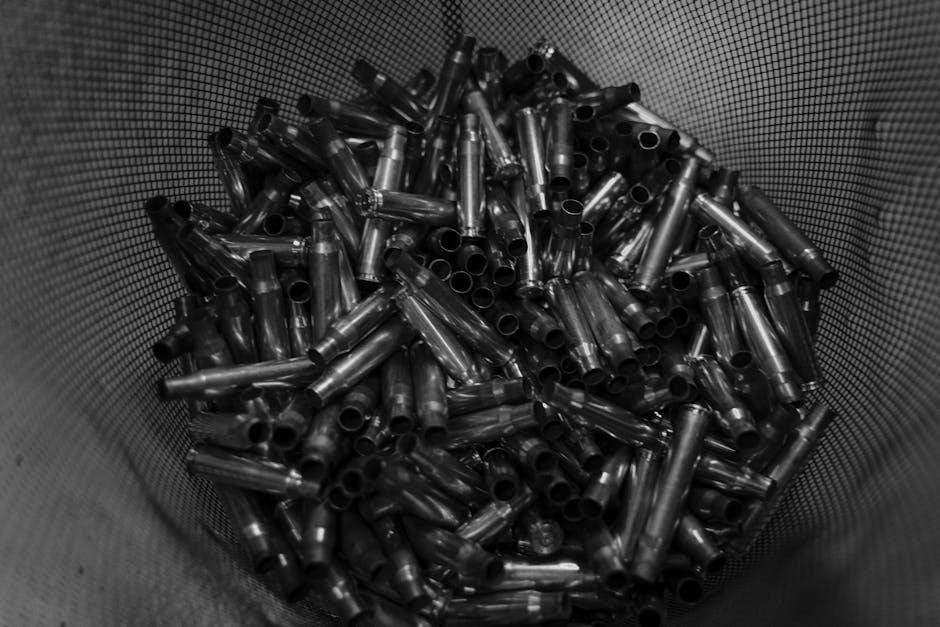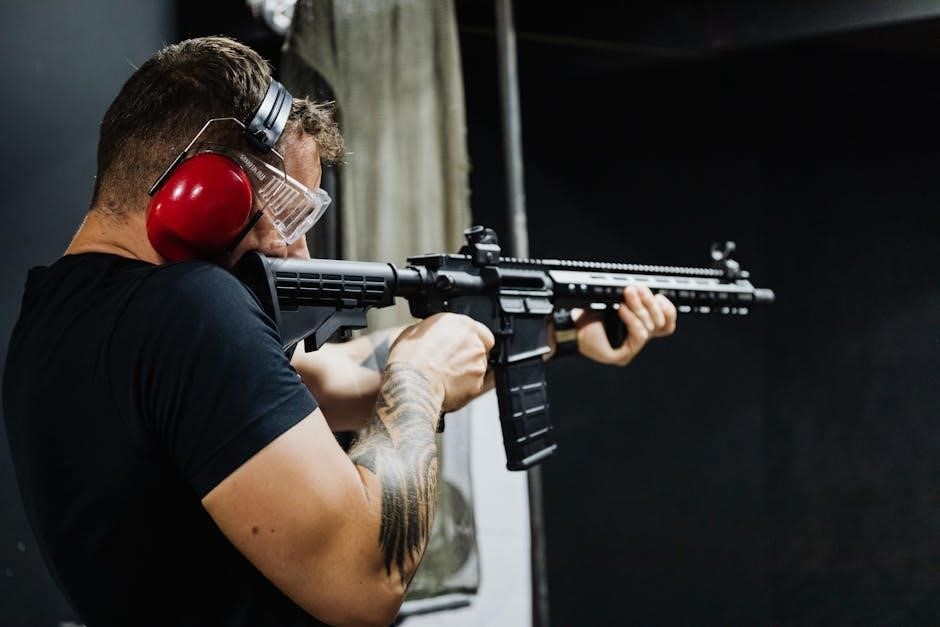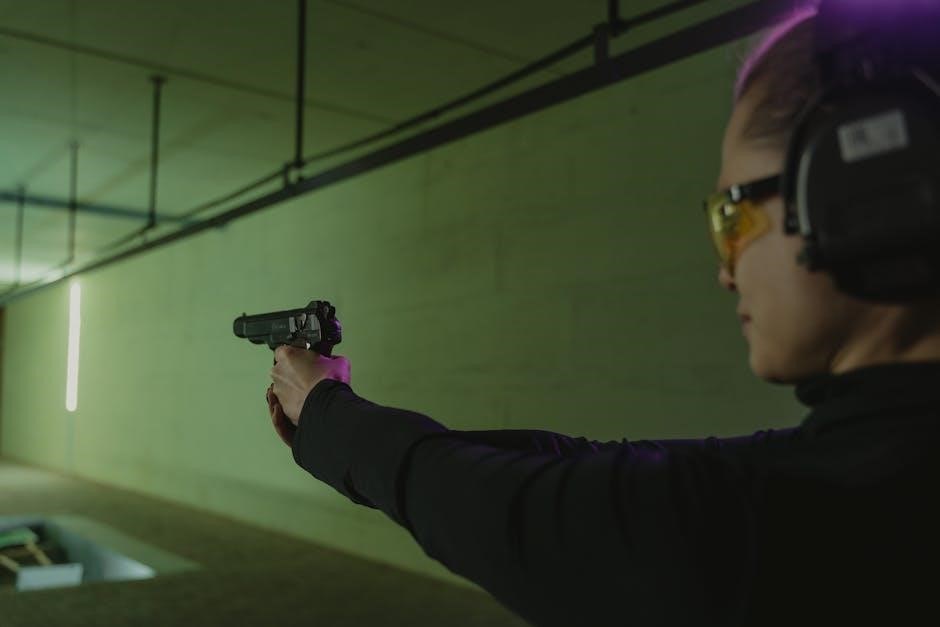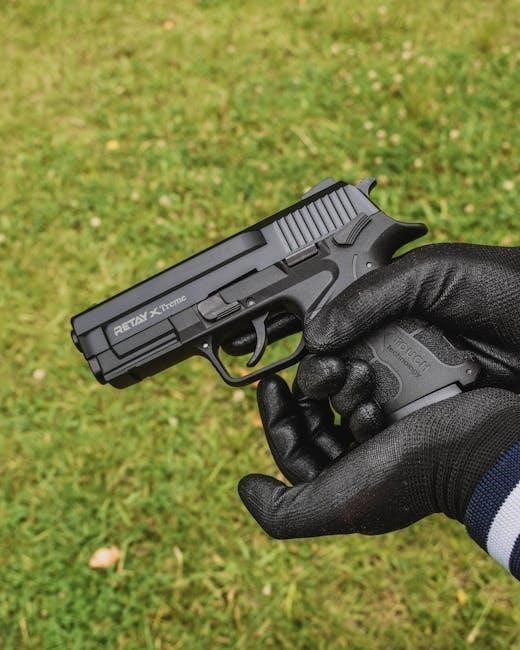Recoil guides are essential components designed to minimize firearm movement during discharge, ensuring accuracy and control. They play a crucial role in maintaining stability across various firearm types.
1.1 Definition and Purpose
Recoil guides are mechanical components designed to manage and reduce the rearward motion of firearms during discharge. Their primary purpose is to enhance stability, accuracy, and control by minimizing barrel movement. These guides often utilize pins and anti-recoil plugs to prevent excessive shift, ensuring consistent performance. By absorbing or redirecting recoil energy, they improve shooter comfort and precision, making them indispensable for both novice and experienced users across various firearm types.
1.2 Importance in Firearm Stability
Recoil guides are critical for maintaining firearm stability by reducing rearward motion during discharge. This ensures consistent accuracy and control, especially in rapid-fire scenarios. By minimizing barrel shift, they enhance precision and reduce shooter fatigue. Properly designed guides distribute recoil energy effectively, preventing excessive movement that could disrupt aim. This stability is vital for both recreational and tactical shooting, making recoil guides an essential component for reliable firearm performance across various calibers and applications.

Types of Recoil Guides
Recoil guides come in various forms, including linear, rotary, and spring-loaded designs, each tailored to specific firearm types and recoil management needs for optimal performance.
2.1 Linear Recoil Guides
Linear recoil guides are mechanisms designed to manage firearm recoil by allowing controlled linear movement. They often feature a pin that contacts the firearm’s frame, preventing excessive rearward motion, which is ideal for maintaining accuracy. These guides are particularly effective in handguns and rifles, where precise control is crucial. Their simplicity and reliability make them a popular choice among shooters, ensuring consistent performance and minimal maintenance over time.
2.2 Rotary Recoil Guides
Rotary recoil guides utilize a rotational mechanism to manage firearm recoil, offering a unique approach to stability. These guides are designed to redirect or absorb recoil forces through rotational movement, which can enhance control during rapid firing. They are often employed in specialized firearms where traditional linear systems may not be sufficient. Their innovative design allows for smoother operation and reduced kickback, making them ideal for high-performance applications and specific shooting scenarios.
2.3 Spring-Loaded Recoil Guides
Spring-loaded recoil guides employ internal springs to absorb and counteract recoil energy. Upon firearm discharge, the spring compresses to cushion the backward motion, then expands to return the system to its original position. This design provides consistent control and reduces wear on the firearm. Ideal for high-recoil weapons, these guides offer reliability and durability, making them a popular choice for both handguns and rifles in various shooting applications and environments.

Components of Recoil Guides
Recoil guides consist of pins, plugs, mounts, and dampening systems. These components work together to absorb recoil energy, ensuring firearm stability and precise alignment during operation.
3;1 Pins and Anti-Recoil Plugs
Pins and anti-recoil plugs are critical components in recoil guide systems. Pins provide a secure anchor point, preventing excessive movement during firearm discharge. Anti-recoil plugs work alongside these pins to absorb and distribute the force of recoil energy. Together, they ensure the firearm remains stable and aligned, enhancing accuracy and control for the shooter. Proper installation and maintenance of these elements are vital for optimal performance and safety.
3.2 Mounts and Brackets
Mounts and brackets are structural components that securely attach recoil guides to firearms. They are typically made from durable materials like aluminum or steel to withstand heavy recoil forces. These mounts ensure proper alignment and stability, preventing any lateral movement during discharge. Brackets often feature adjustable designs, allowing for customization to fit various firearm models. Their robust construction and precise engineering play a vital role in maintaining firearm accuracy and control under recoil stress.
3.3 Dampening Systems
Dampening systems within recoil guides are designed to absorb and dissipate energy generated by firearm recoil. These systems often incorporate hydraulic or spring-based mechanisms to reduce the impact of rearward motion. By cushioning the shock, they prevent damage to both the firearm and the guide itself. Advanced dampening systems may include adjustable settings, allowing users to customize the level of recoil absorption based on specific firearm calibers and personal preference, thereby enhancing overall shooting performance and durability.

Installation and Setup
Installation and setup of recoil guides are crucial for optimal performance and safety. Proper tools and adherence to guidelines ensure correct mounting and alignment. Safety precautions are essential to avoid accidents or damage.
4.1 Tools and Materials Required
Installing recoil guides requires specific tools and materials. Essential tools include wrenches, Allen keys, and screwdrivers. Materials like screws, brackets, and dampeners are necessary. Ensure compatibility with your firearm type. Consult the manufacturer’s manual for specific requirements. Safety gear, such as gloves and goggles, is recommended. Proper preparation ensures a smooth and secure installation process, minimizing potential risks and ensuring optimal performance of the recoil guide system.
4.2 Step-by-Step Installation Process
Begin by preparing the firearm, ensuring it is unloaded and safe to work on. Remove any existing recoil systems or mounts. Align the recoil guide with the firearm’s mounting points, securing it with provided screws. Tighten evenly to avoid misalignment. Install pins or plugs to lock the guide in place. Finally, test the system by simulating recoil to ensure stability. Always refer to the manufacturer’s instructions for specific details and safety guidelines.
4.3 Safety Precautions
Always ensure the firearm is unloaded and safe to handle before installation. Wear protective eyewear and gloves to prevent injury. Properly align the recoil guide to avoid misinstallation, which could cause accidental discharge. Use tools recommended by the manufacturer to prevent damage to the firearm or guide. Never test the system without ensuring all components are securely fastened. Follow the manufacturer’s torque specifications to avoid over-tightening, which may damage the firearm. After installation, test the system in a controlled environment to ensure functionality and safety.

Maintenance and Repair
Regular maintenance ensures optimal performance and longevity. Clean and lubricate moving parts, inspect for wear, and replace components as needed. Follow manufacturer guidelines for repairs and upkeep.
5.1 Cleaning and Lubrication
Cleaning and lubricating recoil guides are vital for smooth operation. Use a soft cloth and mild solvent to remove grime and debris. Apply a thin layer of high-quality lubricant to moving parts, ensuring proper function. Avoid excessive oil, as it can attract dust. Regular maintenance prevents corrosion and wear, ensuring reliability and accuracy in firearm performance. Always follow manufacturer recommendations for cleaning products and lubrication techniques.
5.2 Replacing Worn-Out Parts
Regular inspection of recoil guide components is crucial. Replace worn-out pins, dampeners, or mounts promptly to maintain performance. Use genuine or high-quality replacement parts to ensure reliability. Damaged or corroded elements can compromise firearm stability and accuracy. Always follow manufacturer guidelines for replacement procedures. Proper installation ensures optimal functionality and safety. Neglecting worn parts can lead to reduced accuracy or mechanical failure during use. Addressing wear early prevents more extensive and costly repairs later.
5.3 Troubleshooting Common Issues
Common issues with recoil guides include misalignment, excessive wear, or loosened components. Inspect for damaged pins or dampeners and ensure proper alignment. Clean debris and apply lubrication if necessary. If components are worn, replace them promptly. Misalignment can cause inconsistent performance, so adjust mounts carefully. Regular maintenance helps prevent issues. Addressing problems early ensures reliable operation and maintains firearm accuracy. Always refer to manufacturer guidelines for specific troubleshooting steps.

Applications of Recoil Guides
Recoil guides are widely used in handguns, rifles, and shotguns to enhance stability and accuracy. They are also applied in specialized firearms for improved control and performance.
6.1 Handguns and Pistols
Recoil guides are crucial for handguns and pistols, helping to manage the upward and rearward kick during firing. They enhance accuracy and control, especially in smaller firearms where recoil can be significant. By stabilizing the weapon, shooters can maintain aim and reduce muzzle rise. These guides are often integrated into the firearm’s design or added as aftermarket accessories. They are particularly beneficial for competitive shooters and law enforcement, where precision and rapid follow-up shots are essential. Durable materials and precise engineering ensure reliability in high-stress situations.
6.2 Rifles and Shotguns
Recoil guides are indispensable for rifles and shotguns, where managing the rearward motion is critical for accuracy and control. These systems help reduce kick, especially in high-caliber firearms, ensuring consistent aim. For rifles, they enhance precision during rapid follow-up shots, while for shotguns, they mitigate the intense recoil common in larger gauges. By stabilizing the firearm, shooters can maintain control and deliver precise shots, making them essential for both hunting and tactical applications where reliability is paramount.
6.3 Specialized Firearms
Specialized firearms, such as sniper rifles and heavy-caliber weapons, greatly benefit from advanced recoil guide systems. These systems are tailored to handle the extreme forces generated by high-velocity rounds, ensuring minimal movement during discharge. For sniper rifles, this enhances precision and maintains zero, while for heavy-caliber weapons, it reduces operator fatigue and improves control. Customizable mounts and dampening technologies are often integrated to meet the unique demands of these firearms, making them indispensable for professional shooters and tactical operations where every shot counts and accuracy is critical.

Recoil Reduction Techniques
Recoil reduction techniques involve using recoil pads, muzzle brakes, and proper shooting stance to minimize firearm kick. These methods enhance control and accuracy for shooters of all levels.
7.1 Using Recoil Pads
Recoil pads are attachments installed on firearm stocks to reduce shoulder impact. Made from materials like rubber or gel, they absorb and distribute recoil energy. These pads are particularly beneficial for high-caliber firearms, minimizing discomfort and improving control. Proper installation ensures optimal performance, while adjustable pads allow customization to fit individual preferences. Regular maintenance, such as cleaning and checking pad integrity, is essential for consistent effectiveness. Recoil pads are a simple yet effective solution for enhancing shooting comfort and accuracy.
7.2 Muzzle Brakes and Compensators
Muzzle brakes and compensators are devices attached to a firearm’s barrel to reduce recoil and muzzle rise. By redirecting gases, they mitigate the upward motion of the barrel during firing, improving control. Muzzle brakes are often used on rifles, while compensators are common on handguns. Both designs enhance accuracy and reduce shooter fatigue. Proper installation and alignment are critical for optimal performance. These devices are particularly effective for high-caliber firearms, making them a popular choice among shooters seeking improved stability.
7.3 Proper Shooting Stance
A proper shooting stance is crucial for managing recoil effectively. It involves standing with feet shoulder-width apart, knees slightly bent, and weight evenly distributed. A firm grip on the firearm ensures control, while keeping the body aligned with the target enhances stability. Proper posture helps absorb recoil energy, reducing muzzle rise and improving accuracy. Consistent stance and body positioning are key to mastering recoil control, especially during repeated shots or with high-caliber firearms.

Advanced Features in Modern Recoil Guides
Modern recoil guides incorporate adjustable systems, customizable mounts, and integrated dampening technology for enhanced performance. These features improve functionality, adaptability, and efficiency in various firearm applications.
8.1 Adjustable Recoil Systems
Adjustable recoil systems allow users to customize the level of recoil reduction based on their preferences and firearm specifications. These systems often feature modular components that can be fine-tuned to accommodate different calibers or shooting styles. By enabling precise control over recoil forces, they enhance accuracy and comfort for shooters. Additionally, adjustability ensures compatibility with various firearm models, making these systems versatile and user-friendly. This innovation caters to both novice and experienced shooters, providing optimal performance across diverse shooting scenarios.
8.2 Customizable Mounts
Customizable mounts offer enhanced adaptability, allowing users to tailor recoil guides to specific firearm models or personal preferences. These mounts can be adjusted for length, angle, or fit, ensuring optimal alignment and stability. They often feature interchangeable parts or modular designs, enabling seamless integration with various firearm types. Durable materials and finishes further enhance their reliability and longevity, making customizable mounts a practical choice for shooters seeking precision and versatility in their recoil management systems.
8.3 Integrated Dampening Technology
Integrated dampening technology enhances recoil guides by incorporating advanced materials and mechanisms to absorb recoil energy effectively. This technology often features hydraulic or elastomeric components that reduce vibration and improve stability. By integrating these systems directly into the recoil guide, firearms achieve smoother operation without additional bulk. This innovation minimizes recoil impact, ensuring consistent accuracy and control, making it a valuable advancement for both professional and recreational shooters seeking reliability and performance in their firearms.

Choosing the Right Recoil Guide
Selecting the ideal recoil guide involves considering firearm type, durability, and compatibility. Ensure the guide aligns with your weapon’s specifications for optimal performance and stability.
9.1 Factors to Consider
When selecting a recoil guide, consider firearm type, usage frequency, and environmental conditions. Durability, material quality, and compatibility are crucial. Ensure the guide fits your weapon’s specifications for optimal performance. Proper alignment and ease of installation are also key factors. Additionally, consider the guide’s weight and how it affects the firearm’s balance. Always prioritize safety and reliability to enhance shooting accuracy and control.
9.2 Material and Durability
Durable materials like hardened steel or high-grade alloys are ideal for recoil guides, ensuring longevity under heavy use. Lightweight options, such as titanium or advanced polymers, offer comparable strength without adding bulk. Weather-resistant coatings or finishes enhance reliability in harsh conditions. Assessing the material’s ability to withstand repeated recoil stress is vital for maintaining performance and safety. Always opt for materials that balance strength, durability, and weight for optimal results.
9.3 Compatibility with Firearm Type
Ensuring your recoil guide matches your firearm is crucial for optimal performance. Handguns, rifles, and shotguns each have unique recoil patterns requiring specific guide designs. Compatibility factors include mounting systems, weight distribution, and recoil energy absorption. Always select guides tailored to your firearm type to maintain accuracy and control. Proper fitment prevents damage and enhances reliability, making it essential to choose the right guide for your weapon’s specifications and intended use. This ensures both safety and effectiveness in every shot fired.

Future Trends in Recoil Guide Technology
Future recoil guides may incorporate smart systems, lightweight materials, and energy-harvesting mechanisms to enhance performance and adaptability, ensuring better control and reduced recoil for precise shooting experiences.
10.1 Smart Recoil Systems
Smart recoil systems integrate advanced sensors and real-time adjustments to optimize firearm stability. By adapting to variables like bullet velocity and weapon mass, they enhance accuracy and control, reducing recoil effectively. These systems utilize AI for dynamic calibration, ensuring precision across diverse shooting conditions. Lightweight materials and energy-efficient designs further improve their performance, making them ideal for modern firearms. This technology represents a significant leap in recoil management, offering shooters unparalleled reliability and efficiency.
10.2 Lightweight Materials
Lightweight materials are revolutionizing recoil guide technology by reducing overall weight without compromising strength. Advanced alloys like titanium and aluminum are increasingly used, offering durability while minimizing bulk; These materials enhance portability and ease of use, making firearms more accessible. Their adoption also enables better energy absorption, improving recoil management. As manufacturers innovate, lightweight materials are becoming a cornerstone of modern recoil guide design, balancing performance and practicality for shooters worldwide.
10.3 Energy-Harvesting Mechanisms
Energy-harvesting mechanisms in recoil guides represent a cutting-edge innovation, capturing and converting kinetic energy from firearm recoil into usable electrical energy. These systems integrate advanced materials and piezoelectric components to store energy, potentially powering scopes, sensors, or communication devices. This technology not only enhances operational efficiency but also reduces reliance on external power sources, making it a sustainable solution for modern shooters. Its integration into recoil guides underscores the growing fusion of firearms and smart technology.
